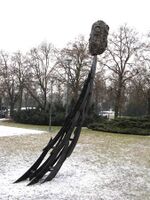12999 Toruń
Topic: Astronomy
 From HandWiki - Reading time: 3 min
From HandWiki - Reading time: 3 min
| Discovery[1] | |
|---|---|
| Discovered by | E. Bowell |
| Discovery site | Anderson Mesa Stn. |
| Discovery date | 30 August 1981 |
| Designations | |
| (12999) Toruń | |
| Named after | Toruń (Polish city)[2] |
| 1981 QJ2 · 1957 TF 1998 QL8 | |
| Minor planet category | main-belt · Baptistina[3] |
| Orbital characteristics[1] | |
| Epoch 4 September 2017 (JD 2458000.5) | |
| Uncertainty parameter 0 | |
| Observation arc | 59.49 yr (21,730 days) |
| |{{{apsis}}}|helion}} | 2.7036 AU |
| |{{{apsis}}}|helion}} | 1.8438 AU |
| 2.2737 AU | |
| Eccentricity | 0.1891 |
| Orbital period | 3.43 yr (1,252 days) |
| Mean anomaly | 168.46° |
| Mean motion | 0° 17m 15s / day |
| Inclination | 5.7705° |
| Longitude of ascending node | 152.34° |
| 210.91° | |
| Physical characteristics | |
| Dimensions | 3.523±0.136 km[4][5] 7.96 km (calculated)[3] |
| Rotation period | 3.5521±0.0026 h[6] |
| Geometric albedo | 0.057 (assumed)[3] 0.392±0.028[4][5] |
| C[3] | |
| Absolute magnitude (H) | 13.773±0.002 (R)[6] · 13.8[1] · 13.9[4] · 14.22[3] |
12999 Toruń, provisional designation 1981 QJ2, is a carbonaceous Baptistina asteroid from the inner regions of the asteroid belt, approximately 8 kilometers in diameter. It was discovered on 30 August 1981, by British–American astronomer Edward Bowell at Lowell Observatory's Anderson Mesa Station in Flagstaff, Arizona, and named after the Polish city of Toruń.[2]
Orbit and classification
Toruń is a carbonaceous C-type asteroid and a member of the small Baptistina family. It orbits the Sun in the inner main-belt at a distance of 1.8–2.7 AU once every 3 years and 5 months (1,252 days). Its orbit has an eccentricity of 0.19 and an inclination of 6° with respect to the ecliptic.[1] The first precovery was taken at Goethe Link Observatory in 1957, extending the asteroid's observation arc by 24 years prior to its discovery.[2]
Physical characteristics
Rotation period
A rotational lightcurve of Toruń was obtained from photometric observations at the U.S. Palomar Transient Factory in December 2009. The provisional lightcurve gave a rotation period of 3.5521±0.0026 hours with a brightness amplitude of 0.09 in magnitude ({{{1}}}).[6]
Diameter and albedo
According to the survey carried out by the NEOWISE mission of NASA's Wide-field Infrared Survey Explorer, Toruń measures 3.5 kilometers in diameter and its surface has a very high albedo of 0.39.[4][5] The Collaborative Asteroid Lightcurve Link (CALL) disagrees with the findings by the space-based mission and assumes a standard albedo for carbonaceous asteroids of 0.057, with a correspondingly larger diameter of 8.0 kilometers with an absolute magnitude of 14.22.[3] As with 1696 Nurmela, another member of the Baptistina family, CALL assumes this asteroid's composition (also see carbonaceous chondrites) to differ significantly from the much brighter asteroid 298 Baptistina, which is considered to be an interloper in its own family.
Naming
In 2008, this minor planet was named after the city of Toruń, Poland. It is the birthplace of Nicolaus Copernicus, significant to Polish and European history, a UNESCO World Heritage listed Old Town, and the main site of the Nicolaus Copernicus University, where its observatory at Piwnice, the largest in Poland, is located. The naming followed a suggestion by Polish astronomer T. Michałowski.[2] The approved naming citation was published by the Minor Planet Center 21 March 2008 (M.P.C. 62354).[7]
References
- ↑ 1.0 1.1 1.2 1.3 "JPL Small-Body Database Browser: 12999 Torun (1981 QJ2)". Jet Propulsion Laboratory. https://ssd.jpl.nasa.gov/sbdb.cgi?sstr=2012999.
- ↑ 2.0 2.1 2.2 2.3 "12999 Torun (1981 QJ2)". Minor Planet Center. https://www.minorplanetcenter.net/db_search/show_object?object_id=12999.
- ↑ 3.0 3.1 3.2 3.3 3.4 3.5 "LCDB Data for (12999) Torun". Asteroid Lightcurve Database (LCDB). http://www.minorplanet.info/PHP/generateOneAsteroidInfo.php?AstInfo=12999%7CTorun.
- ↑ 4.0 4.1 4.2 4.3 Mainzer, A.; Grav, T.; Masiero, J.; Hand, E.; Bauer, J.; Tholen, D. et al. (November 2011). "NEOWISE Studies of Spectrophotometrically Classified Asteroids: Preliminary Results". The Astrophysical Journal 741 (2): 25. doi:10.1088/0004-637X/741/2/90. Bibcode: 2011ApJ...741...90M. http://adsabs.harvard.edu/cgi-bin/bib_query?bibcode=2011ApJ...741...90M. Retrieved 19 May 2016.
- ↑ 5.0 5.1 5.2 Masiero, Joseph R.; Mainzer, A. K.; Grav, T.; Bauer, J. M.; Cutri, R. M.; Dailey, J. et al. (November 2011). "Main Belt Asteroids with WISE/NEOWISE. I. Preliminary Albedos and Diameters". The Astrophysical Journal 741 (2): 20. doi:10.1088/0004-637X/741/2/68. Bibcode: 2011ApJ...741...68M. http://adsabs.harvard.edu/cgi-bin/bib_query?bibcode=2011ApJ...741...68M. Retrieved 3 December 2016.
- ↑ 6.0 6.1 6.2 Waszczak, Adam; Chang, Chan-Kao; Ofek, Eran O.; Laher, Russ; Masci, Frank; Levitan, David et al. (September 2015). "Asteroid Light Curves from the Palomar Transient Factory Survey: Rotation Periods and Phase Functions from Sparse Photometry". The Astronomical Journal 150 (3): 35. doi:10.1088/0004-6256/150/3/75. Bibcode: 2015AJ....150...75W. http://adsabs.harvard.edu/cgi-bin/bib_query?bibcode=2015AJ....150...75W. Retrieved 19 May 2016.
- ↑ "MPC/MPO/MPS Archive". Minor Planet Center. https://www.minorplanetcenter.net/iau/ECS/MPCArchive/MPCArchive_TBL.html.
External links
- Baptistina Asteroid Family and K/T Mass Extinction, Vishnu Reddy, 2013
- Asteroid Lightcurve Database (LCDB), query form (info )
- Dictionary of Minor Planet Names, Google books
- Asteroids and comets rotation curves, CdR – Observatoire de Genève, Raoul Behrend
- Discovery Circumstances: Numbered Minor Planets (10001)-(15000) – Minor Planet Center
- 12999 Toruń at AstDyS-2, Asteroids—Dynamic Site
- 12999 Toruń at the JPL Small-Body Database
 |
 KSF
KSF
